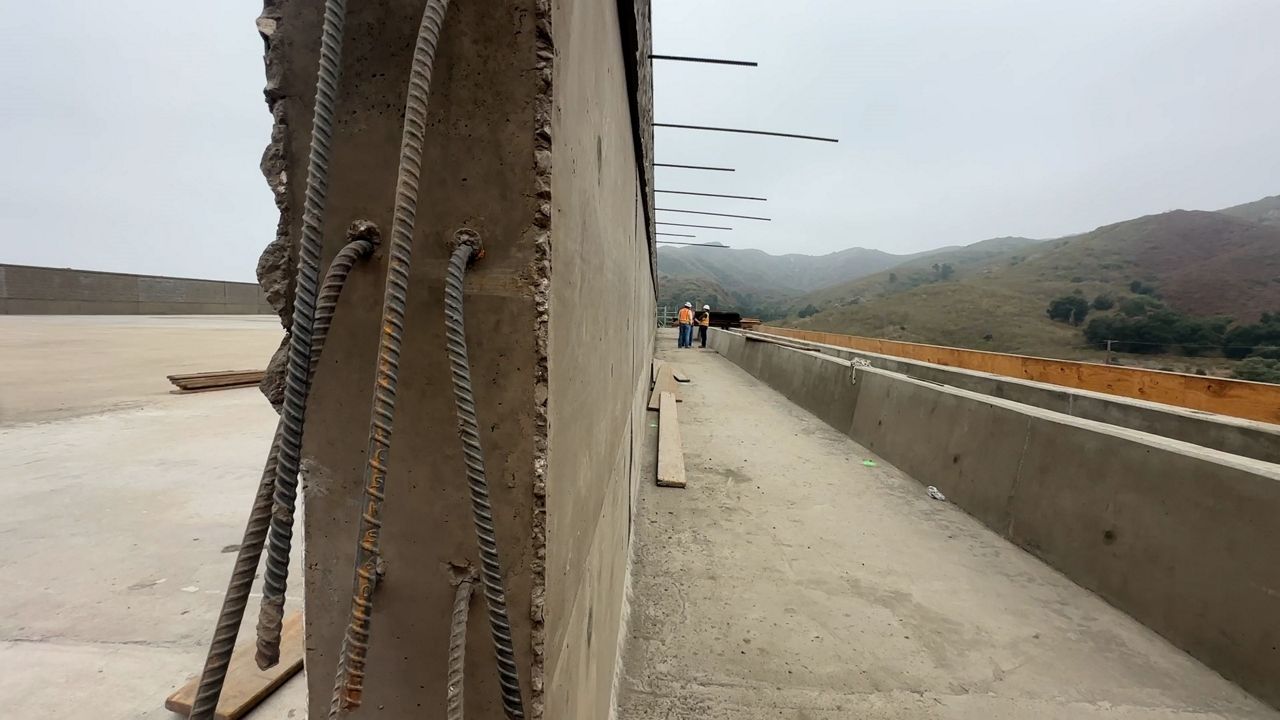AGOURA HILLS, Calif. — The creation of the Wallis Annenberg Wildlife Crossing has been a series of “wow” moments for Beth Pratt of the National Wildlife Federation, with each visit to the site leaving her in a renewed state of awe.
“Every time I come up, there’s something different,” she said, standing in the middle of the concrete slab that completely spans the 101 Freeway. “There’s always really emotional moments, because you just picture wildlife crossing this and what it means for wildlife, eventually.”
Back in April, the project’s longtime advocate stood on the closed southbound side of the freeway, popping champagne as the first giant girder got lowered into place. Now standing above the freeway for the first time since the sound walls went up, Pratt takes a moment to survey the steady progress that’s been made.
“It’s just wonderful to see this, you know, brick by brick, literally … concrete pour by concrete pour get done,” she gushed.
And not just see it … hear it.
The 101 Freeway is a cacophony of cars and trucks, but step to the other side of the sound barrier and the difference is undeniable. The roar dims to a low hum almost instantly, and it’s not even done yet. The poured concrete surface — 27 million pounds of concrete according to Sam Toutounchian of Caltrans — will soon be transformed into a natural habitat involving a deep drainage layer that will then be piled high with 1 to 4 feet of soil to support the coming vegetation.
All of that will help erase the remaining rumble of the freeway.
“So right now, the only real sounds we’re getting are those low-frequency sounds,” Toutounchian explained. “Once we get that material set up on the bridge, it’ll dampen that sound even further.”

That will not only make the space more green but also more serene.
“It’ll be even whisper quiet,” he said, sotto voce. “I’m actually whispering right now. I probably talk louder in my house.”
“In reality, this entire structure is a giant green roof,” added Robert Rock, lead designer on the project and CEO of Rock Design Associates.
In addition to sound, he says the other major factor they had to consider in their design was light pollution coming from the relentless traffic below.
“We’ve got those 300- to 400,000 vehicle trips per day, and it generates a huge amount of sound and a huge amount of artificial light,” Rock said. “Both of those are incredibly impactful on natural areas and habitat quality.”
Like Pratt, he loves visiting the site to get a lion’s eye view of how things are going.
“It’s behind the curtain, you know?” he said. “It’s seeing Oz. We’re seeing the bridge finally come to life, seeing it start to become all of those things we’ve hoped and dreamed that it would become over the course of the last decade.”
“This is an actual tracking collar,” Pratt said as she prepared to secure the large devise around her neck.
For the ninth year in a row, she got ready to embark on her annual 50-mile trek, following in the paw prints of P-22, LA’s most famous mountain lion, who crossed two freeways to get to Griffith Park.
The journey is a key part of Urban Wildlife Week, which began last weekend with the Wildlife 2 Watts event and culminates on Oct. 19 with the P-22 Day Festival, that last year drew 15,000 visitors.
Walking the walk reminds her of what P-22 faced during his perilous migration.
“I’m astounded P-22 even made it to Griffith Park,” she said. “I’m astounded I make it. You know, these cars don’t even slow for a woman on the side of the road, much less wildlife.”
Which is exactly why she says the crossing matters.
“This means safety,” Pratt explained, her eyes scanning the span. “I don’t want another mountain lion hit, you know, and this is going to fix it.”
She says when it’s finished in 2026, the acre-sized plot will ultimately resemble a river of habitat flowing across the freeway, reconnecting the long fractured landscape.



